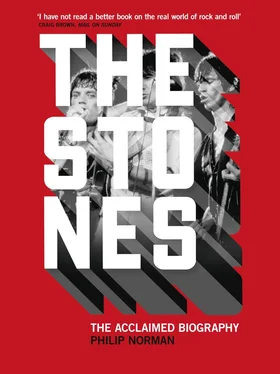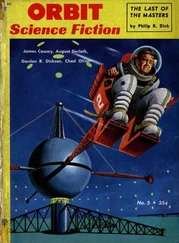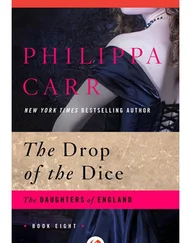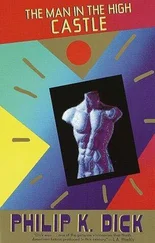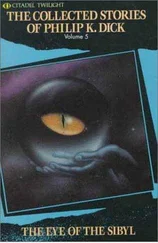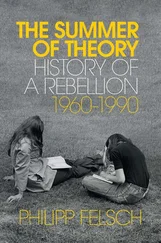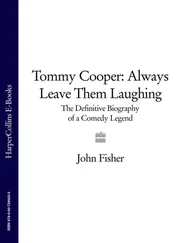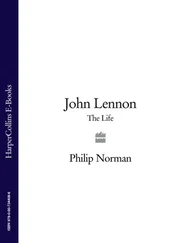For Oldham, it was a matter of sheer convenience. He was tired of rummaging through Chappell’s r & b song catalogue in the perpetual search for material acceptable to the Stones’ purist conscience and to Decca’s A & R department. Their two Top Twenty singles seemed to confirm what Oldham told them with ever increasing frequency: ‘You can’t be a hit group just on rhythm and blues.’ Nor – it was implicitly added – could Oldham himself become the teenage Svengali of British pop just by sorting through sheet music and listening to song pluggers’ demo tapes.
The necessity of putting together a twelve-track LP, to capitalize on their singles’ success, intensified Oldham’s fear that the Stones were in imminent danger of running out of material. Yet again, he looked enviously towards the Beatles, whose own original songs had comprised a good 50 per cent of their second, million-selling album, With The Beatles . Mick and Keith, too, though far from convinced they could concoct a song together, had been deeply impressed by the exercise in instant Lennon–McCartney composition that had produced I Wanna Be Your Man. So, when their manager locked the kitchen door on them in Willesden, they agreed, for the moment, not to kick it down.
Their first attempts at songs were ballads of a glutinous sentimentality, quite unsuitable for the Stones’ repertoire, or for anyone else’s, despite all Oldham’s bullish attempts at syndication. The first ever Jagger-Richard composition, It Should Be You, was eventually recorded by an obscure white soul artist named George Bean. Slightly more success befell another early ballad, That Girl Belongs to Yesterday, when recorded by Gene Pitney, their erstwhile session pianist. Pitney had a minor hit with the song only after drastic rearrangement to suit a piercing voice which, it was said, hit notes that only record engineers and gods could hear.
Only one Jagger-Richard song, Tell Me, was considered good enough for the album released by Decca in April 1964 (although two more tracks bore the Stones’ collective songwriting name, Phelge). Tell Me has curio value as a heavy-handed attempt by Mick and Keith to imitate the Mersey Beat sound of the numerous post-Beatle groups from Liverpool. Strange it is to hear the Stones trying to sound Beatle-ish, with tolling bass drum, minor chords and chocked-up close harmony. Mick Jagger’s ‘Whoa yeah’ rings out in patent embarrassment. Keith Richard descants him, a McCartney made of cigarette ash and Brillo pads.
The other eleven tracks are a belligerently alive memento of the Stones as an r & b band, the way they used to sound at Ken Colyer’s or the Crawdaddy. Given the limitations of a tiny, primitive studio, and severely rationed time there, they could do little else but blast out the best of their club repertoire, imagining an audience in place of Regent Sound’s egg-box walls and Oldham’s agitated eye on the clock. ‘Andrew told us we couldn’t afford retakes,’ Bill Wyman says. ‘The only time we broke was for food, or to let Mick run out and get sheet music for the words of Can I Get a Witness?’
The tracks are a squirming medley from the soul and blues bag: Chuck Berry’s Carol, Bo Diddley’s Mona, Jimmy Reed’s Honest I Do, Willie Dixon’s I Just Wanna Make Love to You. Even then, they could not find quite enough songs, and were forced to throw in a lengthy instrumental sequence vamped around the chords of Can I Get a Witness? featuring Ian Stewart on electric organ, with instrumental breaks by Keith and Brian. There is even a comedy number, Walkin’ the Dog, with Mick Jagger skilfully mimicking Rufus Thomas’s pop-eyed jokiness. The Jagger of this first album is simply a singer with the band, stepping back to allow others their turn. But in every syllable he sings, there are signs of the Jagger to come. There are signs, most powerfully, in Slim Harpo’s I’m a King Bee, a slow blues, torrid with sexual warning – ‘I’m a king bee, baby, buzzin’ round your hive’ – intoned by Jagger in a somnolent drawl, his tongue and lips playing an audible, almost visible part.
The album sleeve was an Oldham tour de force. Borrowed unashamedly from the famous black and white portrait on the cover of With The Beatles , it had one big difference – the subject of prolonged battle between Oldham and Decca’s design department. Even the epoch-making Beatles sleeve bore a title and the artists’ name. Oldham, however, insisted that the Stones’ sleeve should make no statement other than its pictorial one. The five Stones stood sidelong, glowering from shadows so intense, one could barely see the buttons on their Carnaby Street clothes. It was left to the buyer to know who they were and to peer closer at their faces for evidence of animal sullenness or poetic sensitivity. Twenty years on, the look is still modern, the nerve still coolly audacious. On the back, convention returned with song titles, photographs and a sleeve note by Oldham that began: ‘The Rolling Stones are more than a group. They are a way of life …’
By the day of its release, the album had sold 100,000 copies in advance orders. The Beatles – as Oldham jubilantly pointed out – had sold only 6,000 advance copies of their debut album, Please Please Me . He had further cause for glee when the Rolling Stones, climbing up the trade press album charts, displaced With The Beatles on its way down. Oldham, naturally, dismissed the fact that the Beatles album had been in the charts since the previous November. Everywhere he went, to everyone he met, he uttered the same cry of triumph: ‘The Stones have knocked the Beatles off.’
London (AP) Americans – brace yourselves.
In the tracks of the Beatles, a second wave of sheepdog-looking, angry-acting, guitar-playing Britons is on the way.
They call themselves the Rolling Stones and they’re due in New York Tuesday.
Of the Rolling Stones, one detractor has said:
‘They are dirtier and are streakier and more dishevelled than the Beatles, and in some places they’re more popular than the Beatles.’
Says Mick Jagger:
‘I hate to get up in the morning. I’m not overfond of being hungry either.’
From Keith Richard:
‘People think we’re wild and unruly. But it isn’t true. I would say that the most important thing about us is that we’re our own best friends.’
More than the others perhaps, Brian Jones likes clothes. He puts his philosophy this way:
‘It depends on what I feel like really. Sometimes I’ll wear very flamboyant clothes like this frilly shirt. Other times I’ll wear very casual stuff. I spend a lot of my free time buying stuff.’
Then he adds:
‘There’s really not much else to do.’
Misgivings about this first trip to America were by no means all on America’s side. The Stones took off from Heathrow airport on June 6 almost as unhappy about the whole idea. They knew only too well that when the Beatles had reached America four months earlier, it was on the strength of a single lodged firmly at the top of Billboard magazine’s Hot Hundred. Their own first US single, Not Fade Away, coupled with I Wanna Be Your Man, had, since its mid-May release, barely scraped into the Billboard list. Only Andrew Loog Oldham remained unperturbed. The Beatles, he reminded them, had taken two years and three flop singles to ‘break’ in America. Oldham believed he had the contacts and the nerve to make things happen a lot faster than that.
The Rolling Stones were to be launched in America, not as r & b iconoclasts but – in the subtitle of their US debut album – as ‘England’s Newest Hitmakers’, overtly exploiting the craze for British pop which the Beatles had started and which was now too great for even the Beatles to satisfy alone. In this so-called British invasion, the Stones were following some of the groups they most despised – Herman’s Hermits, Billy J. Kramer, the Searchers. ‘Everyone we really hated seemed to be doing far better in the States than we were,’ Bill Wyman remembers. ‘They’d had a number one record, done a good tour, good TV. We’d got nothing like that to look forward to. No wonder we were depressed on the way over.’
Читать дальше
